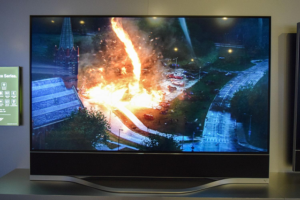Many big names in the TV business were members of the UltraHD Alliance’s UHD Premium certification, when it was announced at CES in January (UltraHD Alliance Launches New Logo). However, there were several companies missing, including Vizio – which has now released a statement giving its reasoning.
Vizio’s Reference Series TVs are not UHD Premium-certifiedWhile Vizio acknowledges that there is value in specifying a premium experience, the UHD-A’s approach is flawed, it says. Details on how metrics such as brightness, light output and contrast ratio should be measured are lacking. Due to this, the programme ‘certifies some products that we don’t believe should qualify for a UHD Premium certification and would ignore other products that should be certified’.
As a specific example, Vizio’s statement points to the 1,000 cd/m² peak brightness measurement, which does not address limitations of blooming or haloing artefacts. ‘The testing requirement only measures the centre brightness point of a test pattern and does not measure how the surrounding black level is affected. To maximise contrast, the peak brightness should be measured at the same time, with the same pattern as black level, as is done with ANSI contrast measurements’.
Similarly, the specification provides two measurements for dynamic range: peak brightness versus black level. 1,000 cd/m² of peak brightness to the specified 0.05 cd/m² black level provides a 20,000:1 contrast ratio. Vizio’s Reference Series (800,000 dynamic contrast) do not, theoretically, meet the UHD-A’s spec.
Because of the above points, Vizio says, it remains focused on the Dolby Vision format. In an interview with Cnet, the firm states that the UHD-A is biased towards certain technologies, ‘and [was created] to prevent other manufacturers’ products from being certified, regardless of their picture quality merits’.
The UHD Alliance, to its credit, did respond to Vizio, although doesn’t mention the claims about measurement methods. It does state that ‘the UltraHD Premium specification is format-agnostic, making a television’s support of HDR10 or Dolby Vision irrelevant’.
Analyst Comment
I had concerns about the UHD Alliance logo when it was first announced, but the reality is that the attempt to get everyone on board was always going to end up in some significant compromise. My disappointment with the logo was that it backed away from full support of the DCI P3 gamut, which would have meant that content created for the cinema could be reproduced on “UHD Premium” sets. It requires only ‘more than 90%’ support. However, there were two barriers to that, as I understand it. The first is that those that are using RG phosphor backlights could not have achieved the Alliance logo and that would have meant some big TV brands being unable to use the logo. So they wouldn’t agree to it.
The second (and this is, to me, a more reasonable point) is that moving to a P3 gamut would have meant a significant increase in power consumption. Clearly, that would be a backward step. However, from my point of view, it would then have been better to say, as the Energy labels sometimes do, that the target would move. That, for example, by 2019, using the logo would need 100% support.
As for issues of measurement, they are, as we have discussed many times, fraught with difficulties, but the best way for the Alliance to go would be, I think, to work with the ICDM on the IDMS standard. No doubt, Vizio is part of the group that is trying to move that standard forward.
It’s also disappointing that the UltraHD Alliance does not seem to have done much to promote its own logo since CES. (BR)

